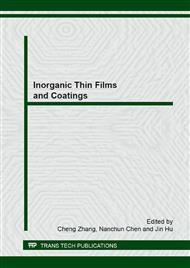[1]
H.Y.P. Hong, Crystal structures and crystal chemistry in the system Na1+xZr2SixP3−xO12, Mater. Res. Bull. 11 (1976) 173-182.
DOI: 10.1016/0025-5408(76)90073-8
Google Scholar
[2]
J.B. Goodenough, H.Y.P. Hong, J.A. Kafalas, Fast Na+-ion transport in skeleton structures, Mater. Res. Bull. 11 (1976) 203-220.
DOI: 10.1016/0025-5408(76)90077-5
Google Scholar
[3]
R.S. Gordon, G.R. Miller, E.D. Beck, J.R. Rasmunssen, Fabrication and characterization of Nasicon electrolytes, Solid State Ionics, 3/4 (1981) 243-248.
DOI: 10.1016/0167-2738(81)90091-6
Google Scholar
[4]
P. Fabrya, J.P. Grosa, J.F. Million-Brodaza, M. Kleitza, Nasicon, Nasicon, an ionic conductor for solid-state Na+-selective electrode, Sensors and Actuators 15 (1) (1988) 33-49.
DOI: 10.1016/0250-6874(88)85016-9
Google Scholar
[5]
N. Miura, S. Yao, Y. Shimizu, N. Yamazoe, Carbon dioxide sensor using sodium ion conductor and binary carbonate auxiliary electrode, J. Electrochem. Soc. 139 (5) (1992) 1384-1388.
DOI: 10.1149/1.2069417
Google Scholar
[6]
S. Yao, Y. Shimizu, N. Miura, N. Yamazoe, Solid Electrolyte CO2 Sensor Using Binary Carbonate Electrode, Chem. Lett. 1990 (1990) 2033-(2036).
DOI: 10.1246/cl.1990.2033
Google Scholar
[7]
S. Yao, Y. Shimizu, N. Miura, N. Yamazoe, Solid electrolyte carbon dioxide sensor using sodium ionic conductor and lithium carbonate-based auxiliary phase, Appl. Phys. A 57 (1993) 25-29.
DOI: 10.1007/bf00331212
Google Scholar
[8]
T. Kida, Y. Miyachi, K. Shimanoe, N. Yamazoe, NASICON thick film-based CO2 sensor prepared by a sol-gel method, Sensors and Actuators B 80 (2001) 28-32.
DOI: 10.1016/s0925-4005(01)00878-4
Google Scholar
[9]
H. Dang, X. Guo, Investigation of porous counter electrode for the CO2 sensing properties of NASICON based gas sensor, Solid State Ionics 201 (2011) 68-72.
DOI: 10.1016/j.ssi.2011.08.011
Google Scholar
[10]
N. Miura, M. Iio, G. Lu, N. Yamazoe, Sodium ion conductor based sensor attached with NaNO2 for amperometric detection of NO2, J. Electrochem. Soc. 143 (1996) L241-L243.
DOI: 10.1149/1.1837158
Google Scholar
[11]
N. Miura, M. Ono, K. Shimanoe, N. Yamazoe, A compact solid-state amperometric sensor for detection of NO2 in ppb range, Sensors and Actuators B 49 (1998) 101-109.
DOI: 10.1016/s0925-4005(97)00335-3
Google Scholar
[12]
N. Miura, M. Iio, G. Lu, N. Yamazoe, Solid-state amperometric NO2 sensor using a sodium ion conductor, Sensors and Actuators B 35 (1996) 124-129.
DOI: 10.1016/s0925-4005(97)80041-x
Google Scholar
[13]
Y. Shimizu, H. Nishi, H. Suzuki, K. Maeda, Solid-state NOx sensor combined with NASICON and Pb-Ru-based pyrochlore-type oxide electrode, Sensors and Actuators B 65 (2000) 141-143.
DOI: 10.1016/s0925-4005(99)00442-6
Google Scholar
[14]
X. Liang, Y. He et al., Solid-state potentiometric H2S sensor combining NASICON with Pr6O11-doped SnO2 electrode, Sensors and Actuators B 125 (2007) 544-549.
DOI: 10.1016/j.snb.2007.02.050
Google Scholar
[15]
X. Liang, T. Zhong, B. Quan, B. Wang, H. Guan, Solid-state potentiometric SO2 sensor combining NASICON with V2O5-doped TiO2 electrode, Sensors and Actuators B 134 (2008) 25-30.
DOI: 10.1016/j.snb.2008.04.003
Google Scholar
[16]
X. Liang, T. Zhong et al., Ammonia sensor based on NASICON and Cr2O3 electrode, Sensors and Actuators B 136 (2009) 479-483.
DOI: 10.1016/j.snb.2008.11.028
Google Scholar
[17]
X. Liang, G. Lu, Ti. Zhong, F. Liu, B. Quan, New type of ammonia/toluene sensor combining NASICON with a couple of oxide electrodes, Sensors and Actuators B 150 (2010) 355-359.
DOI: 10.1016/j.snb.2010.06.061
Google Scholar
[18]
Y. Zeng, D.L. Jiang, P. Greil, Tape casting of aqueous Al2O3 slurries, J. Eur. Ceram. Soc. 20 (2000) 1691-1697.
Google Scholar
[19]
K. Zhu, H. Wang, J. Qiu, J. Luo and H. Ji, Fabrication of 0. 655Pb(Mg1/3Nb2/3)O3-0. 345PbTiO3 functionally graded piezoelectric actuator by tape-casting, J. Electroceram. 27 (2011) 197-202.
DOI: 10.1007/s10832-011-9665-4
Google Scholar
[20]
X.G. Capdevila, J. Folch, A. Calleja, J. Llorens, M. Segarra, F. Espiell, J.R. Morante, High-density YSZ tapes fabricated via the multi-folding lamination process, Ceramics International 35 (2009) 1219-1226.
DOI: 10.1016/j.ceramint.2008.06.018
Google Scholar
[21]
A.K. Maiti, B. Rajender, Terpineol as dispersant for tape casting yttria stabilized zirconia powder, Mater. Sci. Eng., A 333 (2002) 35-40.
DOI: 10.1016/s0921-5093(01)01821-4
Google Scholar
[22]
A. Mukherjee, B. Maiti, A. Das Sharma, R.N. Basu, H.S. Maiti, Correlation between slurry rheology, green density and sintered density of tape cast yttria stabilised zirconia, Ceramics International 27 (2001) 731-739.
DOI: 10.1016/s0272-8842(00)00121-8
Google Scholar
[23]
P.K. Sekhar et al., Application of commercial automotive sensor manufacturing methods for NOx/NH3 mixed potential sensors for on-board emissions control, Sensors and Actuators B, 144 (2010) 112-119.
DOI: 10.1016/j.snb.2009.10.045
Google Scholar
[24]
D.L. West, F.C. Montgomery, T.R. Armstrong, A technique for monitoring SO2 in combustion exhausts: Use of a non-Nernstian sensing element in combination with an upstream catalytic filter, Sensors and Actuators B, 140 (2009) 482-489.
DOI: 10.1016/j.snb.2009.05.012
Google Scholar
[25]
X. Liang, S. Yang et al., Mixed-potential-type zirconia-based NO2 sensor with high-performance three-phase boundary, Sensors and Actuators B, 158 (2011) 1-8.
DOI: 10.1016/j.snb.2011.02.051
Google Scholar
[26]
O. Bohnke, S. Ronchetti, D. Mazza, Conductivity measurements on nasicon and nasicon-modified materials, Solid State Ionics, 122 (1999) 127-136.
DOI: 10.1016/s0167-2738(99)00062-4
Google Scholar
[27]
R.O. Fuentes, F.M. Figueiredo, F.M.B. Marques, J.I. Franco, Influence of microstructure on the electrical properties of NASICON materials, Solid State Ionics 140 (2001) 173-179.
DOI: 10.1016/s0167-2738(01)00701-9
Google Scholar


